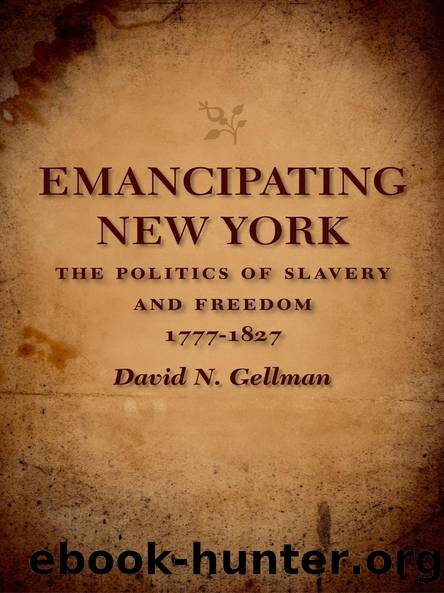Emancipating New York by David N. Gellman

Author:David N. Gellman [Gellman, David N.]
Language: eng
Format: epub
Tags: History, United States, State & Local, General, Revolutionary Period (1775-1800), 19th Century
ISBN: 9780807131749
Google: 6G3T7KCh_3AC
Publisher: LSU Press
Published: 2006-01-15T03:17:14+00:00
III.
By November 1795, the opponents of slavery in New York had decided to renew their commitment to seeking gradual abolition legislation. The previous January, the American Convention had called for state manumission societies to use âevery method in your power which can promise any successâ to alter state laws protecting slavery. At a special meeting in November, the NYMS formed a committee to plan a petition to the legislature, hoping to accumulate the signatures of âas many of the respectable citizens of this Stateâ as possible.44
At the state assemblyâs session in January 1796, Representative James Watson of New York City moved to bring a gradual abolition bill before the lower house. Watson was closely tied to recently elected governor John Jay, himself a man of long-standing antislavery views, and may have acted at Jayâs behest. The Federalist governor, according to a later account by his abolitionist son William, believed that his direct intervention would inspire antagonism on partisan grounds. Such a judgment may have been reasonable given the firestorm over the Jay Treaty and the recent rhetorical standoff with Republicans on the lingering issue of British slave confiscations.45
The assembly responded cautiously. The abolition of slavery became linked with the possibility of compensating slave owners for taking away their property. The assembly also proceeded on the principle that the benefits of any abolition plan would not accrue to men and women presently in bondage but rather to their children. The concept of compensation to owners to be deprived of a full lifetime of service won approval by a one-vote majority. Deferral to a five-man committee of the entire subject of gradual abolition effectively ended its chances for the 1796 session, with compensation having gained a tentative endorsement.46
Proponents of gradual abolition clearly were not sure what mix of principle and strategy to pursue. Thus, compensation confused legislators sufficiently to derail the broader question of emancipation. Watson, who initially brought gradual abolition to the floor, voted in favor of compensation, as did twelve other supporters of gradual abolition. By contrast, a group of fifteen legislators committed to abolition voted against compensation. Those who opposed abolition outright were also split on whether to support compensation.47 The rise of compensation as an important issue exposed the diversity of legislative opinion on how much slaveholder interests should be accounted for in the event of a gradual abolition. It also undermined expeditious legislative consideration of abolition itself.
On the other hand, the question fueled wider public debate over gradual abolition. An unsigned commentary in New York Cityâs Herald reviewed the compensation issue. The writer focused on whether slaveholders could claim property rights in people unborn and, by the same token, whether the state could regulate slaveholderâs access to property that had not yet come into existence. The state legally could set limits on the holdings of corporations, in effect barring corporate bodies from âacquiring a particular species of property, even the interest of their own capital, when the public good requires it.â Thus, the paper implied that the
Download
This site does not store any files on its server. We only index and link to content provided by other sites. Please contact the content providers to delete copyright contents if any and email us, we'll remove relevant links or contents immediately.
| United States | Abolition |
| Campaigns & Battlefields | Confederacy |
| Naval Operations | Regimental Histories |
| Women |
In Cold Blood by Truman Capote(2702)
Steve Jobs by Walter Isaacson(2459)
All the President's Men by Carl Bernstein & Bob Woodward(1971)
Lonely Planet New York City by Lonely Planet(1857)
The Murder of Marilyn Monroe by Jay Margolis(1751)
The Room Where It Happened by John Bolton;(1729)
The Poisoner's Handbook by Deborah Blum(1671)
And the Band Played On by Randy Shilts(1632)
Lincoln by David Herbert Donald(1622)
The Innovators by Walter Isaacson(1612)
A Colony in a Nation by Chris Hayes(1530)
The Innovators: How a Group of Hackers, Geniuses, and Geeks Created the Digital Revolution by Walter Isaacson(1519)
Under the Banner of Heaven: A Story of Violent Faith by Jon Krakauer(1425)
The Unsettlers by Mark Sundeen(1347)
Amelia Earhart by Doris L. Rich(1345)
Birdmen by Lawrence Goldstone(1345)
Decision Points by George W. Bush(1261)
Dirt by Bill Buford(1247)
Zeitoun by Dave Eggers(1231)
